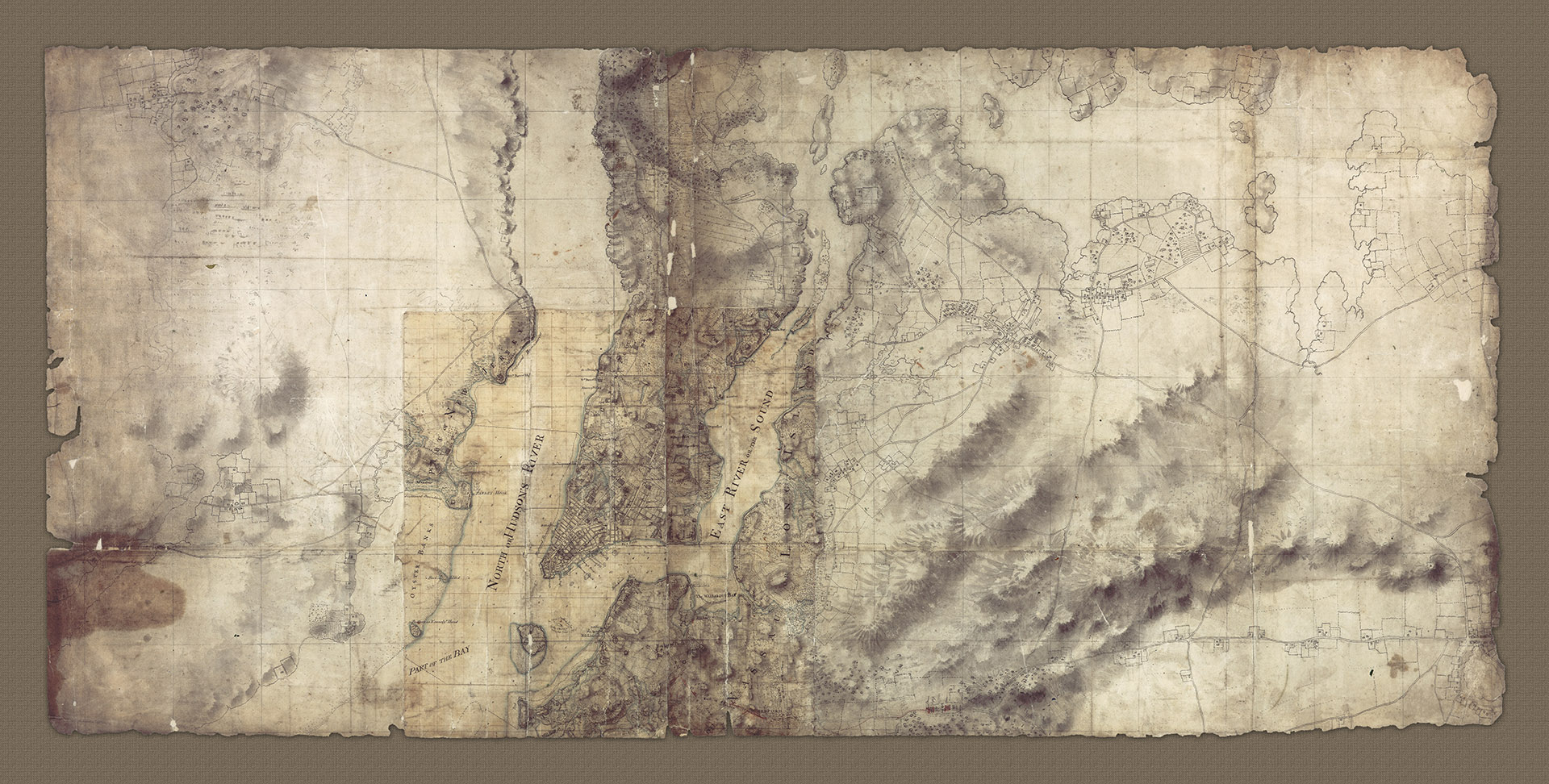
A202 - New York 1776 showing Manhattan with military dispositions marked
A unique and historic hand-drawn map which offers a rare glimpse into the way in which J.F.W. Des Barres put together and utilised material available to him. The real story told by this 'sketch' is that of the events in and around New York after the British landing in September 1776. This is the middle section of a much larger map which extended both south and north of this section.
- 1776
J.F.W. Des Barres
- h27.5" x w54"
- L
Archive ID: UKHO A9459.
This sketch should be viewed alongside Heritage Charts A215 & A216 and the following research article 'Des Barres' Great Folly' which may be found in the Heritage Charts Research Locker or on this link: https://www.heritagecharts.com/great-folly.
The most striking feature of this sketch is the central panel which is almost identical to that of William Faden and Thomas Jeffrey's 'Plan of the City of NewYork..' (see Heritage Chart A201): It details lower Manhattan, although unlike the 'Ratzen' Plan (pub. 1767) and the subsequent Faden & Jeffrey's Plan of the City' it does not name individual streets. It does however share the same soundings in the harbor as the 1770 & 1776 Ratzer Plan of the city and even the print and script on this section of the map are identical.
There is a suggestion that the center panel of this map is, in fact, Ratzer's original drawing for the later Plan of the City. Such a suggestion is supported by the copy grid lines drawn across the middle section and that the detail included beyond the city; fields, buildings, roads, and topographic detail are identical to the area covered by the Faden & Jeffrey's publication (without the view at the bottom). Indeed, the only difference between the two plans is the addition of tide arrows on the North (Hudson) and East Rivers on the published plan.
The extended areas of the map (beyond the scope of the published Ratzer plan) include; the environs of Long Island; the land above the city known as Harlem plains, West Chester and part of the country of New Jersey to the west of the North river. These extended areas are in themselves quite roughly drawn and are certainly not to scale. Relief is contoured by subtle use of water colour, pencil and ink. The roads and settlements, although not named are carefully drawn.
The extension sheets showing the environs of Brooklyn, Queens, Westchester County and New Jersey were added to the map by Des Barre between May and September 1776 to accommodate the unfolding military events of the British invasion and conquest of New York. They were not drawn to be topographically accurate, more to show military detail.
On Long Island, the Headquarters of the British commander-in-chief General William Howe are shown at the house of Samuel Renne on Queens Blvd, Newtown. In addition to the troops garrisoned at Newtown, the regiments garrisoned at Flushing are also shown. This rough map, with the (possible) Ratzer draft in the middle was used by J.F.W. Des Barres for the engraving and making of Heritage Charts A215 and A216, the originals of which are now in the United Kingdom Hydrographic Office and the Library of Congress respectively.
The British controlled the city and its imediate environs after the Americans had retreated back across the river to Manhattan on August 29th after their defeat in the battle of Brooklyn Heights. Initially, the British were concerned that the Americans might cross back to Queens, probably at the Astoria ferry dock where the map shows the deployment of the Royal artillery with 12 and 32 pounders waiting in readiness for such an event. On the 15th September the British landed of 4000 British and Hessian troops under the command of General Henry Clinton at Keps Bay on Manhattan Island (they sailed from Newtown Inlet) and then moved north, scattering the American forces ahead of them. The chart shows the position of British and German troops after the Keps Bay landing just north of Inclenberg (now Murray Hill), just west of the present Lexington Avenue, leading up to the skirmish at Harlem Heights on September 16th 1776.
Overall, the whole map looks very much like a working field map, but the reality is that it was made in London by Des Barres from an old finished survey he had access to and sheets of paper he was able to sketch on from reports he received from colleagues, friends and aquaintences he had in New York at the time.
Reference:'Battle of Long Island', Hard Times followed Battle of Long Island, By GUS DALLAS. www.richmondhillhistory.org/BattleofLI.
- New York 1776 showing Manhattan with military dispositions marked
UKHO A9459


